A.A RAYMOND
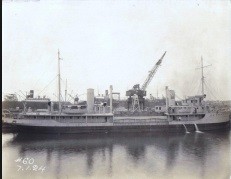
USS Dan C Kingman
Photographer unknown
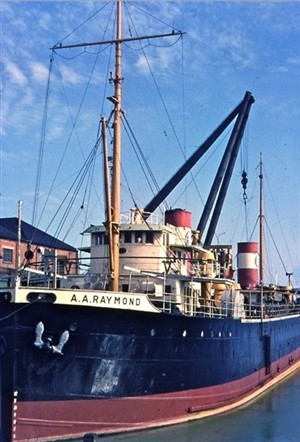
A A Raymond at the Marine Shops. Painted, but the engine work is yet to be done. Those big funnels would soon disappear.
Tony Benger
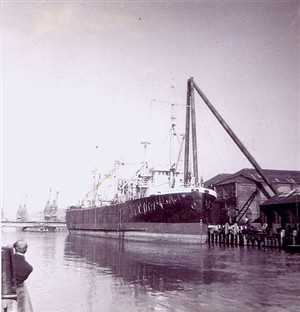
A A Raymond at the Marine Shops. Turned around for painting the other side!
William Still
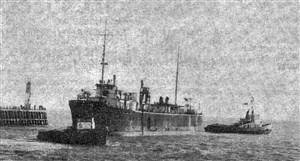
With the work completed, Meeching and Sunnyside tow the AA Raymond to sea for engine trials.
Sussex Express
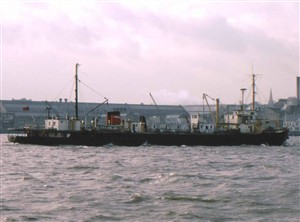
A A Raymond working on the Thames in 1967
Kind permission of Bob Scott
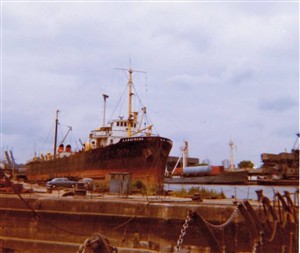
A A Raymond at Bilbao for scrapping in July 1971
'Fairfield' - Ships Nostalgia
The dredger that underwent major works at Newhaven in 1962/63
By Andy Gilbert
Many of us 'of a certain age' will remember seeing the old suction dredger A.A Raymond in the port. I've collected a few photos and details from here on Our Newhaven and elsewhere to tell something of her story.
The 2,313 grt, twin-screw vessel was built in 1924 by Sun Shipbuilding & Drydock Co, Chester, Pennsylvania, USA (Yard no. 60) as Dan C Kingman for the US Corps of Engineers. She was a centre-line trailing suction dredger and was one of the first ships to be powered by diesel electric propulsion. In 1936, while serving with the USCE she helped to construct 'Treasure Island' in San Francisco Bay which involved reclaiming 400 acres of seabed near Alcatraz Island for the site of the Golden Gate Exposition. Her war service was in the Pacific Ocean and included the deepening of Manilla Harbour.
In 1957 she became the Sandon III and she was used in Bangkok to dredge the river channel. She was sold in the same year to Raymond International, who completed the Bangkok contract, and renamed her A.A Raymond after the company's founder.
In 1959 she underwent a $1 million refit before starting work in 1960 for Contractors Equipment Service International Inc. of Panama, who in conjunction with Costains used her to dredge the Bonny River Bar in Nigeria. After only two months on this project she suffered a broken crankshaft, and was laid up pending a decision on her future. She was now 36 years old and her engines were so out of date it was decided that repairs were economically unviable.
However, she was spotted by two enterprising Americans, Messrs. Chick and DuChamp, who operated a fishing fleet in Nigeria, and they bought her to convert to a ballast dredger.
She was towed to Newhaven in 1962 as a drab, grey-hulled, rather plain looking vessel. She soon became part of the harbour furniture. in fact she was here for so long that she regularly appeared in postcards of the town! Whilst here, she was completely repainted, and most photos of her at Newhaven do show her looking quite smart. Throughout 1962 and 1963 she was re-engined with two second-hand Mirrlees JVS12 860 horsepower engines from a 'Ton' class minesweeper, with a third engine of the same make providing diesel electric power for the dredge pump. The old, slow revving diesel engines that were taken out weighed 180 tons each, the replacement Mirrlees engines just 14 tons! Apparently, all of the Chick and DuChamp families worked on her whilst she was here.
For most of the time here she was berthed up at the Marine Workshops on the Railway Quay, but when underwater work needed to be done, she was shifted downriver to the South Hard, just south of Sleepers' Hole, as she was too big for the Railway Quay gridiron. She was a 'dead ship' with no power and had to be moved around the harbour by the Meeching, with assistance from one of the Metrec tugs.
After being re-engined she sailed under her own power from Newhaven to Flushing in Holland, where she was converted to a side trailing suction and pump ashore self-discharge dredger. This was possibly the first time that this method of discharging an aggregate dredger had been used.
Her American owners operated as the Orrisdale Steamship Company, based in the Isle of Man, but A A Raymond continued to be registered in Panama. In 1964 she went on charter to J.Murphy & Sons, who had constructed a special discharge wharf at Barking, Essex. In 1966 she was sold to Hall (Marine) Ltd, a subsidiary of Hall & Co. The photo from Bob Scott shows her in Hall's livery, passing Tilbury on 31st December 1967.
For a large ship, she had a rather small rudder and this made her difficult to steer. She would yaw from side to side, even in the best of weather, and other ships had to be wary when passing near her. Local marine radio stations were known to give out warnings that 'A A Raymond is tacking her way in!'
In May 1971 she was laid up in the Royal Docks, and was subsequently sold to breakers in Bilbao, Spain, where she arrived in July 1971. The final photo here comes courtesy of 'Fairfield' on Ships Nostalgia. He took the photo when she arrived at the port for scrapping. Quite possibly the last photo taken of her.
My thanks to 'Andy S' and 'Awateah 2' on Ships Nostalgia, plus our own William Still here at Our Newhaven for the extra information on her career.